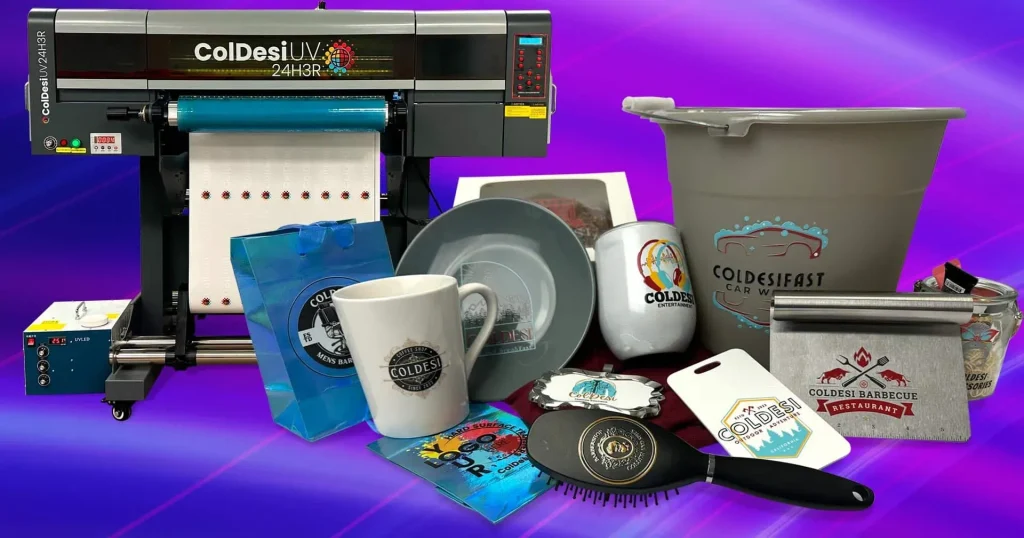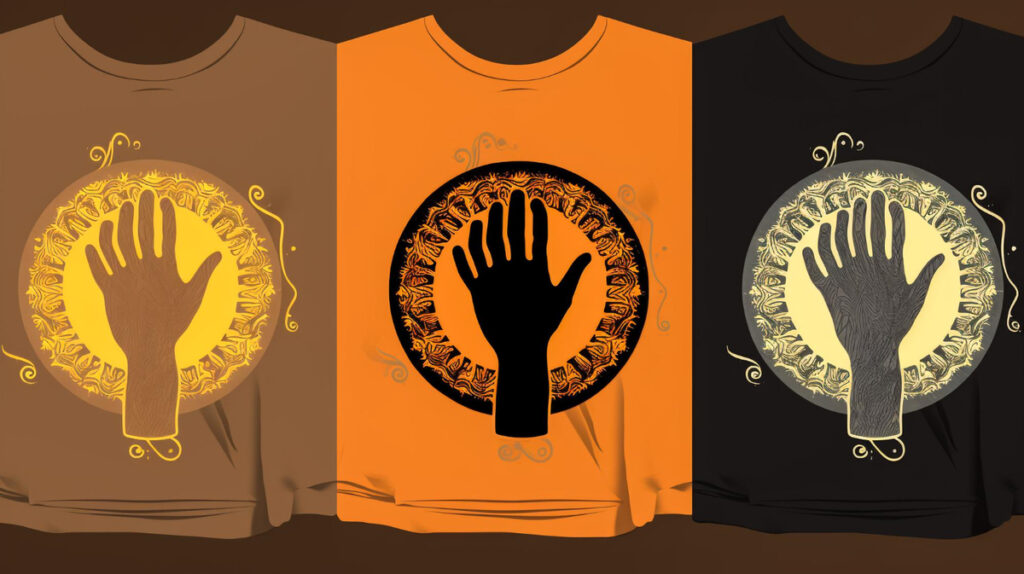UV DTF printing is transforming the world of custom printing through innovative UV printing technology that merges speed and sustainability. This advanced method of Direct-to-Film printing utilizes ultraviolet light to instantly cure ink, allowing for stunning imagery on various substrates with incredible precision. As industries increasingly focus on eco-friendliness, UV DTF stands out due to its lower emissions compared to traditional printing methods, marking a significant step toward sustainable printing solutions. Furthermore, this innovative technique promotes customization in printing, enabling businesses to create unique and vibrant products that meet specific client demands. By adopting UV DTF gangheet techniques, brands can not only enhance their production processes but also align with modern consumer expectations for quality and environmental responsibility.
The emergence of UV Direct-to-Film printing signals a new era in the printing industry, characterized by efficiency and versatility. Often referred to as DTF printing, this method harnesses the power of UV light to cure inks directly onto films, revolutionizing how materials are printed. These advancements are particularly impactful in sectors that prioritize customization in printing and sustainable practices, as they allow for a high level of personalization while reducing waste. Additionally, gangheet techniques enable the simultaneous production of multiple prints, enhancing operational efficiency and meeting market demands swiftly. As the landscape of printing continues to evolve, embracing innovative technologies like UV DTF will be crucial for businesses aiming to stay ahead in a competitive marketplace.
The Science Behind UV DTF Printing
UV Direct-to-Film (DTF) printing is a cutting-edge technology that utilizes ultraviolet light to instantly cure ink onto films, ensuring bright, vivid prints that can be produced rapidly. This innovative approach contrasts sharply with traditional methods that rely on solvents and lengthy drying times, making UV DTF not only faster but also more efficient in terms of resource usage. By curing the inks with UV light, printers can achieve intricate designs with precision, which is particularly beneficial for businesses concerned with maintaining brand integrity and quality.
Furthermore, the science behind UV DTF involves using specialized UV inks that are tailored to adhere to a wide variety of materials, which expands the possibilities for printed products. Whether printing on textiles, hard surfaces, or flexible materials, the versatility of UV DTF technology allows manufacturers to produce diverse items ranging from custom apparel to robust signage. As a result, businesses can cater to a broader customer base while creating unique products that stand out in the competitive market.
Benefits of UV DTF Technology in Printing
Adopting UV DTF printing technology presents a plethora of benefits for companies aiming to modernize their printing operations. One of the primary advantages is the reduced curing time achieved through UV curing, which allows prints to be handled immediately after production. The fast turnaround enables businesses to respond swiftly to customer demands, enhance service levels, and ultimately increase customer satisfaction. This efficiency can significantly impact overall workflow, leading to enhanced productivity and reduced bottlenecks in the production process.
Moreover, UV DTF printing is known for its eco-friendly practices, aligning with global sustainability goals. The technology utilizes inks low in volatile organic compounds (VOCs), which contribute to lower environmental impact compared to traditional printing methods. As industries increasingly prioritize sustainable practices, businesses leveraging UV DTF can position themselves as responsible and environmentally-conscious brands, appealing to eco-aware consumers who favor sustainable options.
Customization Capabilities with UV DTF Printing
Customization in printing has become a critical component for businesses looking to stand out in a crowded marketplace. UV DTF printing facilitates exceptional levels of personalization, allowing companies to create custom designs for their customers rapidly. This capability is particularly advantageous for promotional items, apparel, and personalized gifts where unique branding can significantly influence consumer purchasing decisions. The clarity and vibrancy of UV DTF prints ensure that even the most intricate designs are represented accurately, enhancing the appeal of customized products.
Additionally, with the flexibility inherent in UV DTF printing, brands can easily adapt to changing market trends or seasonal demands. This agility means that companies can produce small batches of customized items without the need for significant set-up times or costs typically associated with traditional methods. As a result, UV DTF supports a business model that is not only customer-centric but also responsive to emerging trends, ensuring that companies can continuously engage their target market effectively.
The Role of Gangheet Techniques in UV DTF Printing
Gangheet techniques have emerged as a significant advancement in the realm of UV DTF printing, enabling multiple prints to be produced simultaneously in a single batch. This approach maximizes efficiency, as printers can run higher volumes without sacrificing quality. The gangheet method streamlines the printing process, significantly reducing wastage of materials and optimizing production timelines. As brands look to implement more efficient operations, the integration of gangheet techniques can provide a competitive edge.
Moreover, gangheet techniques can lead to cost savings for businesses by minimizing material use and optimizing ink consumption. By allowing multiple designs to be printed in one pass, companies can improve their profit margins while offering a wider range of products. This method not only benefits production efficiency but also enhances product diversity, essential for businesses wanting to cater to various markets and consumer preferences.
Market Trends: The Future of UV DTF Printing
As the UV printing market continues to grow, projections indicate that UV DTF technologies will play a pivotal role in transforming the landscape of the printing industry. With a projected annual growth rate of nearly 10%, businesses are increasingly looking to integrate UV DTF printing due to its remarkable speed, quality, and sustainability. The demand for unique, customizable products is on the rise, as consumers desire personalized items, reflecting their individuality or brand identity. This trend emphasizes the need for printing solutions that can adapt to fast-paced consumer demands.
Industries such as fashion, promotional merchandise, and packaging are particularly poised to benefit from UV DTF technology. The adaptability of this printing method allows businesses to produce creative designs that captivate consumers, using high-quality prints that are durable and visually appealing. As companies explore new ways to differentiate themselves, the strategic implementation of UV DTF printing signals a significant transformation in how products are marketed and produced, making it an essential consideration for any forward-thinking business.
Navigating Challenges in UV DTF Transition
Despite the numerous advantages of adopting UV DTF printing technology, businesses may face challenges when transitioning from traditional printing methods. One of the primary concerns is the initial investment cost associated with high-quality UV DTF printing equipment. Companies must carefully assess their budget and estimate the potential return on investment to ensure a successful transition. While the upfront costs may be substantial, the long-term efficiency and cost-saving benefits can outweigh these initial investments.
Furthermore, transitioning to UV DTF printing often requires comprehensive training for personnel. Adequate training ensures that employees understand the complexities of operating UV DTF equipment and can maintain consistent quality in the final products. Businesses can mitigate this challenge by investing in proper training programs and resources for their teams, ensuring that every operator becomes adept at the technology. This effort not only enhances the quality of prints but also boosts overall productivity, thereby reinforcing the decision to shift towards UV DTF printing technology.
Frequently Asked Questions
What is UV DTF printing and how does it work?
UV DTF printing, or Ultraviolet Direct-to-Film printing, utilizes ultraviolet light to cure special inks directly onto films. This process allows for vibrant, high-quality prints that adhere well to a range of substrates such as textiles, plastics, and metals. Unlike traditional printing methods, UV DTF printing offers immediate handling of printed items, significantly reducing production time and enhancing efficiency.
What are the key benefits of using UV DTF printing technology?
The key benefits of UV DTF printing technology include rapid curing times, which allow for quick handling of products, versatility in printing on various materials, a lower environmental impact through the use of eco-friendly inks, and enhanced durability of prints that resist fading and scratching. These advantages make UV DTF a preferred choice for businesses looking to optimize their printing processes.
How does UV DTF printing support sustainable printing practices?
UV DTF printing supports sustainable printing practices by utilizing eco-friendly inks that produce lower volatile organic compound (VOC) emissions. This approach minimizes environmental impact compared to traditional printing techniques, aligning with the industry’s shift towards more sustainable practices. Additionally, the efficiency of UV DTF reduces material waste, making it a responsible choice for eco-conscious companies.
In what ways can UV DTF printing offer customization in printing?
UV DTF printing offers extensive customization in printing by allowing for high-resolution designs on various substrates. The technique’s versatility enables businesses to create customized promotional products, apparel, and signage tailored to specific needs. This level of personalization enhances brand identity and customer engagement, making UV DTF printing an essential tool for businesses aiming for creative differentiation.
What are gangheet techniques in UV DTF printing?
Gangheet techniques in UV DTF printing refer to the production method that allows multiple prints to be created simultaneously in one batch. This process increases efficiency and reduces material waste, enabling printers to maximize output while minimizing costs. By leveraging gangheet techniques, businesses can streamline their printing operations and improve overall productivity.
What challenges should businesses consider when adopting UV DTF printing?
When adopting UV DTF printing, businesses should consider challenges such as initial equipment investment costs, which can be significant, especially for small enterprises. Additionally, staff training is essential to ensure operators are familiar with the technology, including color management and equipment maintenance, to maintain high-quality outputs. Understanding these challenges can help businesses make informed decisions about transitioning to UV DTF printing.
| Key Points | Details |
|---|---|
| Overview of UV DTF Printing | Utilizes UV light to cure ink on films for vibrant colors and excellent adherence. |
| Efficiency | Reduced curing times and immediate handling capabilities lead to quicker production cycles. |
| Material Versatility | Can print on textiles, plastics, metals, and glass, allowing for diverse applications. |
| Environmental Impact | Utilizes eco-friendly inks with lower VOC emissions, supporting sustainability. |
| Durability | Resistant to fading, scratching, and washing, ensuring a long lifespan for prints. |
| Gangheet Techniques | Enables batch production for efficiency and reduced material costs. |
| Market Trends | Expected growth of nearly 10% annually, driven by demand for customization. |
| Challenges | High initial investment and training requirements for operators. |
Summary
UV DTF printing is reshaping the landscape of modern printing technology by offering enhanced quality, speed, and application versatility. This innovative process utilizes ultraviolet light to cure inks directly onto a variety of substrates, providing vibrant colors and strong adhesion. A major advantage of UV DTF printing is its rapid curing times, which significantly increase production rates and reduce operational waste. By adopting eco-friendly practices, such as lower VOC emissions and reduced drying time, businesses can align with sustainability trends while still catering to the growing demand for customized printed products. As UV DTF technology continues to evolve, it stands as a vital solution for companies looking to remain competitive in an ever-changing market.



